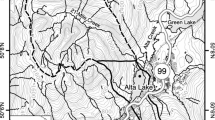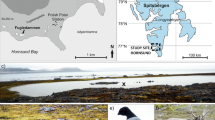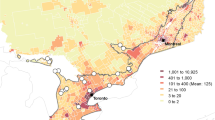Abstract
Kettle ponds in the Cape Cod National Seashore in southeastern Massachusetts differ in their evolution due to depth of the original ice block, the clay content of outwash in their drainage basins, and their siting in relation to geomorphic changes caused by sea-level rise, barrier beach formation, and saltmarsh development. Stratigraphic records of microfossil, carbon isotope, and sediment changes also document late-glacial and Holocene climatic changes.
The ponds are separated into 3 groups, each of which follow different development scenarios. Group I ponds date from the late-glacial. They formed in clay-rich outwash, have perched aquifers and continuous lake sediment deposition. The earliest pollen and macrofossil assemblages in Group I pond sediments suggest tundra and spruce-willow parklands before 12 000 yr B.P., boreal forest between 12 000 and 10 500 yr B.P., bog/heath initiation and expansion during the Younger Dryas between 11 000 and 10 000 yr B.P., northern conifer forest between 10 500 and 9500 yr B.P., and establishment of the Cape oak and pitch pine barrens vegetation after 9500 yr B.P. Sedimentation rate changes suggest lowered freshwater levels between 9000 and 5000 yr B.P. caused by decreased precipitation on the Atlantic Coastal Plain. Lake sediment deposition began in the middle Holocene in Group II ponds which formed in clay-poor outwash. These ponds date from about 6000-5000 yr B.P. In these ponds sediment deposition began as sea level rose and the freshwater lens intersected the dry basins. The basal radiocarbon dates of these ponds and stable carbon isotope analyses of the pond sediments suggest a sea-level curve for Cape Cod Bay. Holocene topographic changes in upland and the landscape surrounding the ponds is reconstructed for this coastal area.
Group III ponds in the late Holocene landscape of the Provincelands dunes originated as interdunal bogs about 1000 yr B.P. and became ponds more recently as water-levels increased. Peat formation in the Provincelands reflects climatic changes evident on both sides of the Atlantic region.
Similar content being viewed by others
References
Anderson, T. W., 1985. Late-Quaternary pollen records from eastern Ontario, Quebec, and Atlantic Canada. In V. M. Bryant, Jr. & R. G. Holloway (eds.), Pollen Records of Late-Quaternary North American Sediments. Amer. Assoc. of Strat. Palyn. Found., Dallas, TX: 281–326.
Berglund, B. E. & M. Ralska-Jasiewiczowa (eds), 1986. Handbook of Holocene paleoecology and paleohydrology. J. Wiley & Sons, N.Y., 869 pp.
Brugam, R. B., 1978. Human disturbance and the historical development of Linsley Pond. Ecol. 59: 19–36.
Burden, E. T., G. Norris & J. H. McAndrews, 1986. Geochemical indicators in lake sediment of upland erosion caused by Indian and European farming, Awenda Provincial Park, Ontario. Can. J. Earth Sci. 23: 55–65.
Charles, D. F. & S. A. Norton, 1986. Direct comparison of diatom and chemical data: Paleolimnological evidence for trends in atmospheric deposition of acids and metals. In Monitoring and Assessment of Trends in Acid Deposition. National Academy of Sciences Report 402.
Charles, D. F., D. R. Whitehead, D. R. Engstrom, B. D. Fry, R. A. Hites, S. A. Norton, J. S. Owen, L. A. Roll, S. C. Schindler, J. P. Smol, A. J. Uutala, J. R. White & R. J. Wise, 1987. Paleolimnological evidence for recent acidification of Big Moose Lake, Adirondack Mountains, N.Y. (USA). Biogeochem. 3: 267–296.
Cole, K. L., D. R. Engstrom, R. P. Futyma & R. Stottlemyer, 1990. Past atmospheric deposition of metals in northern Indiana measured in a peat core from Cowles Bog. Envir. Sci. Technol. 24: 543–549.
Cwynar, L. C., A. J. Levesque, F. E. Mayle & I. Walker, 1994. Wisconsinan Late-glacial environmental change in New Brunswick: a regional synthesis. J. Quat. Sci. 9: 161–164.
Davis, R. B., T. E. Bradstreet, R. Stuckenrath, Jr., & H. W. Borns, Jr., 1975. Vegetation and associated environments during the past 14 000 years near Moulton Pond, Maine. Quat. Res. 5: 435–465.
Dean, W. E., Jr., 1974. Determination of carbonate and organic matter in calcareous sediments and sedimentary rocks by loss on ignition: comparison with other methods. J. Sed. Petrol. 44, 242–248.
Denton, G. H. & T. J. Hughes (eds), 1981. The Last Great Ice Sheets. Wiley Interscience, N.Y.: 484 pp.
Digerfeldt, G., 1975. Post-glacial water-level changes in Lake Vaxjosjon, central southern Sweden. Geologiska Foreningens i Stockholm Forhandlingar 97: 167–173.
Dyke, A. S. & V. K. Prest, 1987. Late Wisconsin and Holocene history of the Laurentide Ice Sheet. Geog. phys. et Quat. 41: 237–263 and Geological Survey of Canada Maps 1702A and 1703A.
Engstrom, D. R., E. B. Swain & J. C. Kingston, 1985. A paleolimnological record of human disturbance from Harvey's Lake, Vermont: geochemistry, pigments and diatoms. Freshw. Biol. 15: 261–288.
Engstrom, D. R. & H. E. Wright, Jr., 1984. Chemical stratigraphy of lake sediments as a record of environmental change. In E. Y. Haworth & J. W. G. Lund (eds), Lake Sediments and Environmental History. Leicester: 11–67.
Faegri, K. & J. Iversen, 1975. Textbook of Pollen Analysis. Hafner Press, N.Y., 295 pp.
Fassett, N. C., 1957. A manual of aquatic plants. The University of Wisconsin Press, Madison, 405 pp.
Fernald, M. L., 1950. Gray's manual of botany, 8th ed. Dioscorides Press, Portland, 1632 pp.
Florin, M. B. & H. E. Wright, Jr., 1969. Diatom evidence for the persistence of stagnant glacial ice in Minnesota. Geol. Soc. Am. Bull. 80: 695–704.
Frey, D. G., 1986. Cladocera analysis. In Berglund, B. E. & M. Ralska-Jasiewiczowa (eds), Handbook of Holocene Palaeoecology and Palaeohydrology. John Wiley & Sons, N.Y.:667–692.
Gorham, E., 1957. The development of peat lands. Quat. Rev. Biol. 32: 145–166.
Gorham, E., 1991. Northern peatlands: role in the carbon cycle and probable responses to climatic warming. Ecol. App. 1: 182–195.
Gray, J., 1965. Extraction techniques. In B. Kummel & D. Raup (eds), Handbook of paleontological techniques. W. H. Freeman & Co., San Francisco: 530–587.
Hutchinson, G. E., 1975. A treatise on limnology, 1. J. Wiley & Sons, N.Y., 1015 pp.
Jorgensen, N., 1978. A Sierra Club naturalist's guide to southern New England. Sierra Club Books, San Francisco, 417 pp.
Kutzbach, J. E., P. J. Guetter, P. J. Behling & R. Selin, 1993. Simulated climatic changes: results of the COHMAP climate-model experiments. In H. E. Wright Jr, J. E. Kutzbach, T. Webb III, W. F. Ruddiman, F. A. Street-Perrott & P. J. Bartlein (eds), Global Climates since the Last Glacial Maximum, University of Minnesota Press, Minneapolis, MN: 24–93.
Leatherman, S. P., 1979. Evolution of the Province Lands. In S. P. Leatherman (ed), Environmental Geological Guide to Cape Cod National Seashore. Field Trip Guide Book for the ESPM. Univ. of Massachusetts-Amherst: 193–206.
Livingstone, D. A., 1968. Some interstadial and postglacial pollen diagrams from eastern Canada. Ecol. Mono. 38: 87–125.
McCaffrey, C. A., 1973. An ecological history of the Province Lands, Cape Cod National Seashore. University of Massachusetts, Amherst, Report No. 1, National Park Service-Cooperative Research Unit, 71 pp.
Mott, R. J., 1987. The Late Glacial in Atlantic Canada. 12th INQUA Abstracts: 229.
Norton, S. A., 1986. A review of the chemical record in lake sediment of energy related air pollution and its effect on lakes. Wat. Air Soil Pollut. 30: 331–345.
Ogden, J. G. III, 1963. The Squibnocket Cliff peat: radiocarbon dates and pollen stratigraphy. Am. J. Sci. 261: 344–353.
Oldale, R. N., 1986. Late-glacial and postglacial sea-level history of New England: a review of available sea-level curves. Archaeology of eastern North America 14: 89–99.
Oldale, R. N., 1988. A Late Wisconsinan marine incursion into Cape Cod Bay, Massachusetts. Quat. Res. 30: 237–250.
Oldale, R. N., 1982. Pleistocene stratigraphy of Nantucket, Martha's Vineyard, the Elizabeth Islands, and Cape Cod, Massachusetts. In G. J. Larson & B. D. Stone (eds.), Late Wisconsinan glaciation of New England. Kendall/Hunt, Dubuque, IA: 1–34.
Oldale, R. N., 1992. Cape Cod and the Islands: The Geologic Story. 1st ed., East Orleans, Mass. Parnassus Imprints, 208 pp.
Oldale, R. N., 1993. Radiocarbon ages from two submerged strandline features in the western Gulf of Maine and a sea-level curve for the northeastern Massachusetts coastal region. Quat. Res. 40: 38–45.
Peteet, D. M., 1987. Younger Dryas in North America — modeling, data analysis, and reevaluation. In W. H. Berger & L. D. Labeyrie (eds.), Abrupt Climatic Change. D. Reidel, Hingham (MA): 185–193.
Peteet, D. M., J. S. Vogel, E. E. Nelson, J. R. Southon, R. J. Nickmann & L. E. Heusser, 1990. Younger Dryas climatic reversal in Northeastern USA? AMS ages for an old problem. Quat. Res. 33: 219–230.
Portnoy, J. W. & M. A. Soukup, 1988. Can the Cape's diked salt marshes be restored? Cape Naturalist 17: 28–33.
Redfield, A. C. & M. Rubin, 1962. The age of salt marsh peat and its relation to recent changes in sea level at Barnstable, Massachusetts. Proc. Natn. Acad. Sci. 48: 1728–1735.
Roman, C. T., 1987. An evaluation of alternatives for estuarine restoration management: The Herring River Ecosystem (Cape Cod National Seashore). Center for Coastal and Environmental Studies. The State University of New Jersey, New Brunswick (N.J.), 304 pp.
Ruddiman, W. F. & A. McIntyre, 1981. The mode and mechanism of the last deglaciation: oceanic evidence. Quat. Res. 16: 125–134.
Strahler, A. N., 1966. A Geologist's View of Cape Cod. 1st ed., Natural History Press, Garden City, N.Y. Published for the American Museum of Natural History by the Natural History Press, 115 pp.
Tzedakis, P. C., 1992. Effects of soils on the Holocene history of forest communities, Cape Cod Massachusetts, USA. Geograph. phys. Quat. 46: 112–124.
U.S.G.S. Maps, 1972. Wellfleet, Mass. AMS 6967 INE-Series V814.
Whiteside, M. C., J. P. Bradbury & S. J. Tarapchak, 1980. Limnology of the Klutlan moraines, Yukon Territory, Canada. Quat. Res. 14: 130–148.
Winkler, M. J., 1982. Late-glacial and postglacial vegetation history of Cape Cod and the paleolimnology of Duck Pond, South Wellfleet, Massachusetts. M.S. thesis. University of Wisconsin-Madison, 118 pp.
Winkler, M. G., 1985a. Charcoal analysis for paleoenvironmental interpretation: a chemical assay. Quat. Res. 23: 313–326.
Winkler, M. G., 1985b. A 12 000-year history of vegetation and climate for Cape Cod, Massachusetts. Quat. Res. 23: 301–312.
Winkler, M. G., 1988. Paleolimnology of a Cape Cod kettle pond: diatoms and reconstructed pH. Ecol. Mono. 58: 197–214.
Winkler, M. G., 1989. Geologic, chronologic, biologic, and chemical evolution of the acid kettle ponds within the Cape Cod National Seashore. Report to the National Park Service, North Atlantic Region, 145 pp.
Winkler, M. G., 1990a. The evolution of modern and ancient interdunal bogs in the Provincelands of the Cape Cod National Seashore. Report to the National Park Service, North Atlantic Region, 39 pp.
Winkler, M. G., 1990b. I. Recent changes in trophic status of Duck and Bennett Pond in the Provincelands relative to possible landfill enrichment. II. Evolution of interdunal ponds in the Provincelands, Cape Cod National Seashore. Provincetown Ponds Final Report, National Park Service, North Atlantic Region, 38 pp.
Winkler, M. G., 1990c. Two estuaries in the Cape Cod National Seashore: diatom documentation of environmental change. In G. Larson & M. Soukup (eds), Proceedings of the 1986 conference on science in the national parks, Vol. 6, Fisheries and Coastal Wetlands Research: 171–184.
Winkler, M. G., 1992. Development of parabolic dunes and interdunal wetlands in the Provincelands, Cape Cod National Seashore. In C. H. Fletcher III & J. F. Wehmiller (eds), Quaternary Coasts of the United States: Marine and Lacustrine Systems. SEPM-IGCP Special Publication #48: 57–64.
Winkler, M. G., 1993. Changes at Walden Pond during the last 600 years: microfossil analyses of Walden Pond sediments. In E. A. Schofield & R. C. Baron (eds), Thoreau's World and Ours: A Natural Legacy. North American Press, Golden (CO): 199–211.
Winkler, M. G., 1994a Development of the Gull Pond Chain of Lakes and the Herring River Basin, Cape Cod National Seashore, Final Report. Part II. North Atlantic Region, National Park Service, 228 pp.
Winkler, M. G., 1994b. Modern limnology of the Provincelands Ponds. Final Report. Part I. North Atlantic Region, National Park Service, 121 pp.
Winkler, M. G. (in press). Late Quaternary climate, fire, and vegetation dynamics. In J. S. Clark, H. Cachier, J. G. Goldammer & B. J. Stocks (eds), Sediment records of biomass burning and global change. Springer-Verlag, Berlin.
Wright, H. E., Jr., 1989. The amphi-Atlantic distribution of the Younger Dryas paleoclimatic oscillation. Quat. Sci. Rev. 8: 295–306.
Wright, H. E., Jr., J. E. Kutzbach, T. Webb III, W. F. Ruddiman, F. A. Street-Perrott & P. J. Bartlein (eds), 1993. Global Climates since the Last Glacial Maximum. University of Minnesota Press, Minneapolis, 569 pp.
Zeigler, J. M., S. D. Tuttle, H. J. Tasha & G. S. Giese, 1965. The age and the development of the Provincelands Hook, Outer Cape Cod, Massachusetts. Limnol. and Oceanog. 10 (Supplement): R298-R311.
Author information
Authors and Affiliations
Additional information
This is the 8th in a series of papers published in this special AMQUA issue. These papers were presented at the 1994 meeting of the American Quaternary Association held 19–22 June, 1994, at the University of Minnesota, Minneapolis, Minnesota, USA. Dr Linda C. K. Shane served as guest editor for these papers.
Rights and permissions
About this article
Cite this article
Winkler, M.G., Sanford, P.R. Coastal Massachusetts pond development: edaphic, climatic, and sea level impacts since deglaciation. J Paleolimnol 14, 311–336 (1995). https://doi.org/10.1007/BF00682431
Received:
Accepted:
Issue Date:
DOI: https://doi.org/10.1007/BF00682431




